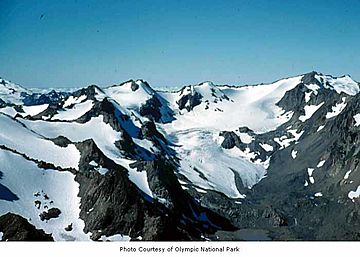Mount Carrie facts for kids
Quick facts for kids Mount Carrie |
|
|---|---|

Mt. Carrie (right), Ruth Peak (left) and Fairchild Glacier
|
|
| Highest point | |
| Elevation | 6,995 ft (2,132 m) |
| Prominence | 1,675 ft (511 m) |
| Isolation | 6.24 mi (10.04 km) |
| Geography | |
| Location | Olympic National Park Clallam County, Washington, US |
| Parent range | Olympic Mountains |
| Topo map | USGS Mount Olympus |
| Geology | |
| Age of rock | Eocene |
| Type of rock | grey sandstone |
| Climbing | |
| Easiest route | Scrambling YDS 2 via the High divide Trail and Cat Walk |
Mount Carrie is a tall mountain, about 6,995-foot (2,132-metre) high. It's found inside Olympic National Park in Clallam County, Washington. It's the highest peak in the Olympic Mountains' Bailey Range. On a clear day, you can even see it from the Hurricane Ridge visitor center!
Mount Carrie's closest higher peak is Mount Mathias, which is about 6.24 mi (10.04 km) to the south. Because of lots of snow in winter, Mount Carrie has two glaciers: the Carrie Glacier on its northeast side and the Fairchild Glacier on its east side. Water from the mountain flows into the Elwha River and Hoh River. You can reach the top by following a path called the High Divide Trail and Cat Walk, which involves some scrambling.
History of Mount Carrie's Name
The Olympic Peninsula was mostly unknown on maps until the late 1800s. Two surveyors, Arthur Dodwell and Theodore Rixon, mapped most of the area between 1898 and 1900. In 1899, what we now call Mount Carrie was one of the last unnamed mountains in the Olympic range.
Theodore Rixon named the mountain after his wife, Caroline "Carrie" (Jones) Rixon. Carrie Rixon was a talented artist, painter, and singer. She also taught music to children. The Rixons lived in a home they called Fairholme near Lake Crescent until 1916. Carrie Rixon passed away on May 20, 1946.
Weather Around Mount Carrie
Mount Carrie is in a "marine west coast" climate zone. This means it gets a lot of rain and snow. Most weather systems come from the Pacific Ocean and move towards the Olympic Mountains. When these systems hit the tall mountains, the air is forced upwards. This causes the moisture in the air to fall as rain or snow. This process is called Orographic lift.
Because of this, the Olympic Mountains get a lot of rain, especially in winter. During winter, it's usually cloudy. But in summer, high pressure systems over the Pacific Ocean often bring clear skies. The best time to visit and climb Mount Carrie is usually from July to September, when the weather is most pleasant.
Images for kids




